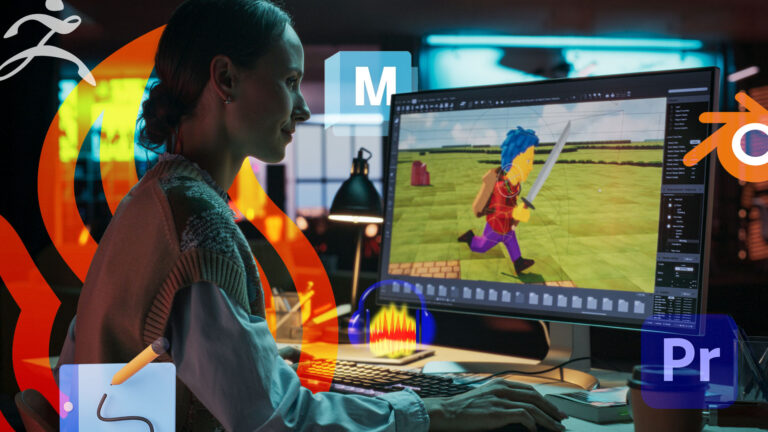The latest video game releases require multiple years of development and teams with hundreds of video game designers in order to meet the lofty expectations of modern gamers. Due to the sheer amount of people needed to make a game function properly, a budding video game designer should have no shortage of opportunities in the coming years. That being said, it is worth examining the life of a video game designer before diving headfirst into a code document. This way you will know for sure if becoming a video game designer is the optimal career path for you.
What Does it Take to Become a Video Game Designer?
While video game designers come from all backgrounds and walks of life, there are several proclivities and personality traits that many video game designers share. These include a passion for gaming, technical skills, and the drive to create something special. If you can embody each of these core elements, then you are a prime candidate for a career as a video game designer.
A Passion for Gaming
Video game designers who love games end up making much better titles. They have insider knowledge on what players want. Experiencing the best and worst that video games have to offer is a great way to inform your own creation process. Keeping up with the latest trends also lets video game designers know what expectations they need to meet in order to impress today’s gamers.
Technical Know-How
Creating virtual worlds is one of the most challenging things you can do with a computer. The more tech-savvy you are, the easier time you will have adjusting to such an advanced environment. Plus, technology is always advancing, and tools are constantly being revised or swapped out. The ability to quickly pick up and understand both new hardware and software is crucial to the success of a video game designer.
Creativity and Persistence
Just like any other art form, video games require an immense amount of creativity. A video game designer will need an abundance of imagination to find creative solutions and solve complex problems. Speaking of issues, they will also need to have the persistence necessary to endure frustrating development hurdles. Game breaking bugs are a natural part of game creation. A video game designer will need the perseverance and passion for games to push towards victory even when the hours get long, and little progress is made.
What Does a Video Game Designer Do?
The daily life of a video game designer involves working with a team and setting up a plan of attack. Then, individuals split off into smaller groups and get to work on their smaller goals. After some time has passed, the teams come together again and report their progress. This is how each facet of the video game is slowly iterated on until the release date approaches.
The Many Video Game Designer Specialty Roles
Each designer has a specialty role that determines which of the smaller groups they are placed into. These specialty roles are needed in order to flesh out every aspect of the game and make the final product as polished as possible. By splitting up the workload, video games can be finished faster with higher degrees of quality. Although every development studio is different, here are some of the most common examples of specialty roles that a game designer can adopt.
Level Design
Level designers are responsible for creating the space that players will explore. This includes the placement of enemies, obstacles, and other objects throughout each game level. However, it isn’t enough to simply place items at random. Level designers do their utmost to ensure each scenario is fun to play through. If a game is going for an immersive or narrative approach, level designers must also make the world seem believable. This allows players to enjoy the story and atmosphere without being reminded they are playing a video game.
Art Direction
The art direction refers to the overall style of the project. Most titles have a primary aesthetic that is presented throughout the journey. Video game designers in charge of the direction ensure that every art asset looks like it belongs in the video game’s world. It takes an army to provide all of the vivid details that gamers expect in modern AAA franchises.
Programming
Every video game relies on code to function properly. There is no shortage of programmers behind all of the popular game titles. Programmers often split into further categories since each aspect of video game development requires extensive coding. For instance, a video game designer may decide to become a programmer that specializes in combat. Studios would hire them primarily to create systems and mechanics that make the combat more enjoyable. In most cases, they would continue to refine all parts of the battle system until the game’s launch.
Character and Story Writing
Cinematic games where the story takes center stage have become popular in recent years. Games often require a team of writers to finish the thousands of sentences necessary on a video game project. Even video games without extensive stories have lots of writing. Every item the gamer encounters often has a lengthy description that adds to the lore. There are also writers that specialize in developing characters over the course of the story. These roles are especially vital to keeping the player engaged with the tale.
Sound Designers and Music Composers
Audio is one of the hallmarks of great video game design. Without sound as feedback, games become boring and lose all impact. Sound designers spend time recording sound effects that make the actions on-screen more believable. If something sounds off, the gamer’s brain will instantly recognize it and take them out of the experience.
Music is so important to games that a special composer is often called in. These composers develop the themes associated with each level, character, and event that occurs throughout the game. A good soundtrack helps a gamer match the mood or emotion that the video game designers intended them to have while playing.
Usability and UI
Ever played an older game, then it is clear just how hard some of simpler video games can be to enjoy. This is because older titles didn’t apply the principles of usability into their design. Usability makes something easier for a person to understand and use without needing external help. In the context of video games, this includes the user interface and other features that help a gamer navigate through the world without hassle. A whole team of video game designers work on making the menus, UI and controls as painless as possible for gamers to use.
Animators
Finally, it takes a team of animators to capture the movement and reaction of each object or character in the game world. Animators can work with both 2D and 3D space to create believable motion. Games require a complex set of animations for both practical and aesthetic reasons. The more unique animations a game has, the more fluid and natural the world will appear.
Who Do Video Game Designers Work With?
As mentioned above, video game designers work with hundreds of other developers to finish a project on time. No matter which specialty role they fall into, they will have to interact with other teams and eventually answer to the project leads. These leads include creative directors, executive producers, art leads, and anyone else who is higher up in the company than the video game designer. Since there are so many people working towards one vision, it takes a comprehensive set of managers and leads to keep everyone on the same page.
Investors and Shareholders
Those who fund each project serve as an external force that video game designers must also work with. Video games are a business and everyone who took a chance on the company financially expects to see a return on their investment. It is worth noting that business and artistic decisions will inevitably collide during production. Video game designers must work within the parameters established by shareholders while delivering the best quality title they can to the players.
Where Do Video Game Designers Typically Work?
Most game studios have at least one large office building that houses a majority of their staff. Bigger publishers have multiple studios around the world that usually work on different games at the same time. Development offices tend to be rather open to encourage teamwork and collaboration among video game designers. There will rarely be any cubicles walling people off. Instead, wide spaces are used to allow employees to freely move and communicate with their colleagues.
Video game development can also be done remotely through the use of revision control software. Since video game design is done with computers, team members can use video communications to work directly from home. Revision control software allows each video game designer to log and save each change they make to the project. Then, it allows each video game designer to sync up their files with the latest version of the title. This helps keep everything organized when video game designers can’t work together in the same building.
Why is a Career in Game Development So Exciting?
Game development is a rapidly evolving industry that witnesses technological leaps every few years. Compared to most other career paths, video game design rarely involves repeating the same things day in and day out. Changes to both hardware and software force video game designers to constantly learn new things and try different techniques. It is hard to imagine what games will look like even ten years from now.
Plus, video games are routinely eclipsing the total annual revenue made by every other entertainment industry. Demand for video game designers is only going to expand as more companies create new video games. With the sheer amount of people needed to create each title, there will be no shortage of available positions. This makes a career in video game design the perfect synthesis of security and excitement.
Did learning about what a video gamer designer does interest you? As the video game industry continuously grows, employers are zeroed in on game design and development program students who understand both the creative and technical sides of the industry. Nowhere is University of Silicon Valley’s unique ability to combine specializations better demonstrated than in our Game Design & Development Department.
In the Game Design Art degree concentration, your studies will include the foundation of game design mechanics, gameplay principles, interactivity, and the means for creating and refining game content. Building on that foundation, as well as the technical aspects of 3D animation software and game engines, you will create visually impressive gaming environments that tell meaningful stories, convey thoughtfulness, create emotion and are just all-around fun to play. The Game Art degree concentration is all about designing, creating, and bringing to life the visual components of games in a highly-collaborative teaching environment that simulates a working studio.
University of Silicon Valley is uniquely poised to offer a meaningful and valuable education for 21st century students. We believe in an education that directly correlates with the work you’ll be doing after you graduate. Interested in learning more? Contact Us today.


